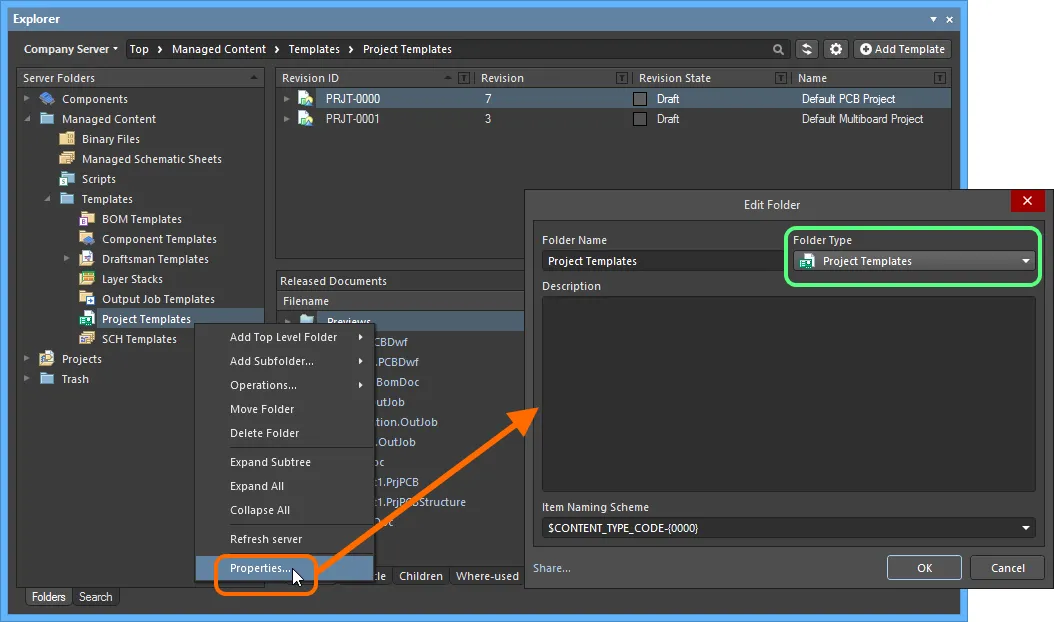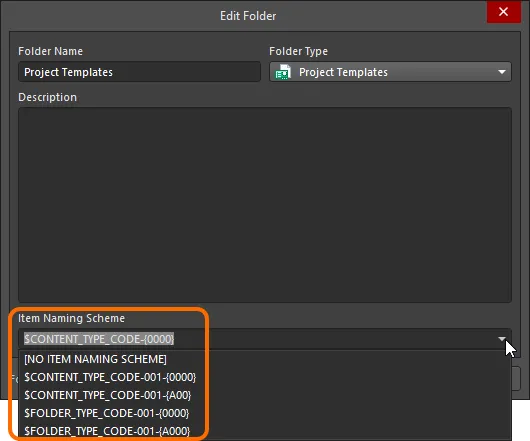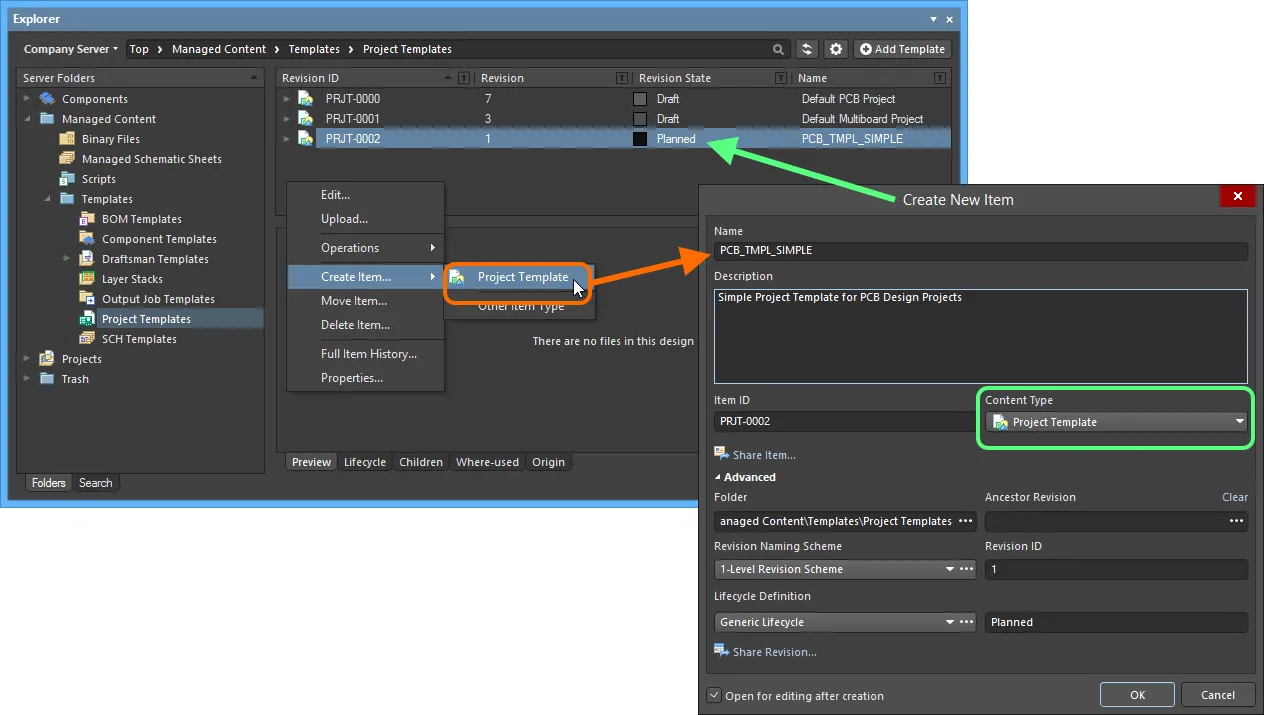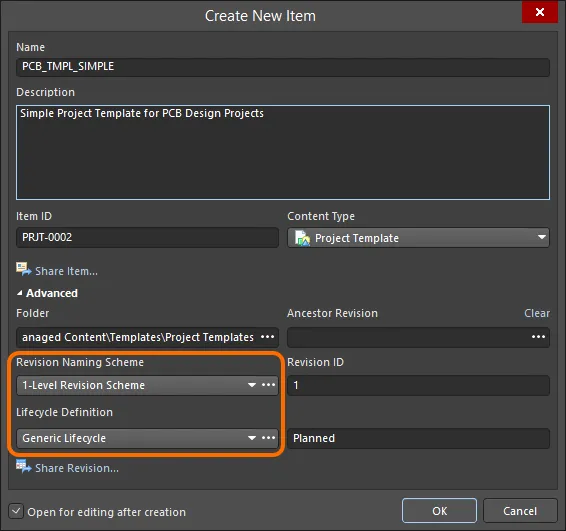Parent page: Server Items
Altium Designer, in conjunction with your managed content server, caters for the ability to create and manage Project Template Items in that server. Such Items can be created through Direct Editing.
Once a Project Template Item has been created (and data released into a revision of it), and its lifecycle state set to a level that the organization views as ready for use at the design level, it can be reused in the creation of future design projects.
Project Template Items can be created for PCB and Multi-board project types.
Managed Project Templates stored in the server can include the common document and file types that make up a project, as well as additional reference documentation and configuration files.
In addition, a managed Project Template Item can be used as a configuration data item in one or more defined Environment Configurations. An environment configuration is used to constrain a designer's Altium NEXUS working environment to only use company-ratified design elements. Environment configurations are defined and stored within the Team Configuration Center - a service provided through the NEXUS Server installation, and the facilitator of this concept of Environment Configuration Management.
Folder Type
When creating the folder in which to store Project Template Items, you can specify the folder's type. This has no bearing on the content of the folder - releasing a project as a template will always result in a corresponding Project Temp late Item. It simply provides a visual 'clue' as to what is stored in a folder and can be beneficial when browsing a server for particular content. To nominate a folder's use as a container for Project Template Items, set its Folder Type as Project Templates, when defining the folder properties in the Edit Folder dialog.

Specifying the folder type - its intended use - gives a visual indication of the content of that folder when browsing the server.
Item Naming Scheme
Another important aspect of the parent folder is the Item Naming Scheme employed for it. This defines the format of the unique ID for each Item created in that particular folder. Several default example schemes are available, utilizing the short-form code for either the folder type (PRJT - Project Templates) or the content type (PRJT - Project Template):
- $CONTENT_TYPE_CODE-001-{0000} - for example, PRJT-001-0001.
- $CONTENT_TYPE_CODE-001-{A00} - for example, PRJT-001-A01.
- $FOLDER_TYPE_CODE-001-{0000} - for example, PRJT-001-0001.
- $FOLDER_TYPE_CODE-001-{A000} - for example, PRJT-001-A001.
Using a default naming scheme, the software will automatically assign the next available unique ID, based on that scheme, having scanned the entire server and identifiers of existing Items. This can be a great time-saver when manually creating Project Template Items.
A custom scheme can also be defined for a folder, simply by typing it within the field, ensuring that the variable portion is enclosed in curly braces (e.g. PRJ-TMP-{0000}).

The Item Naming Scheme of the parent folder is applied to the Unique ID for each Item
created within that folder.
The Item Naming Scheme employed for the parent folder can be changed at any time. The modified scheme will then be applied to any subsequent newly-created Items within that folder.
Item Type
When creating a target Project Template Item in which to store your project, ensure that its Content Type is set to Project Template, in the Create New Item dialog. If you are creating the Item in a Project Templates type folder, this Item type will be available from the right-click context menu when creating the Item.

Creating a Project Template Item within a Project Templates folder - the correct Content Type is available on the context menu.
Item Lifecycle Definition and Revision Naming
When defining a Project Template Item, be sure to specify the type of lifecycle management to be used for the Item, and the naming scheme employed for its revisions, respectively.
Control over which Item types can use a particular lifecycle definition or revision naming scheme, can be defined and enabled at a global level from within the Content Types dialog, when defining each schema. The default schemes assigned for use by a Project Template Item are: Generic Lifecycle and 1-Level Revision Scheme, respectively.
Once a project has been released into the initial revision of a Project Template Item, these schemes cannot be changed for that particular Item.
Specify the required schemes in the Create New Item dialog, using the Lifecycle Definition and Revision Naming Scheme fields respectively.
If the option to control use of lifecycle definitions and revision naming schemes per content type is enabled for any definitions/schemes, and the Project Template Item type is not set to use a particular definition/scheme, then that definition/scheme will not be available in the applicable drop-down list.

Selecting the Lifecycle Definition and Revision Naming schemes for a manually created Item.
Observing standard revision naming schemes and lifecycle definitions, across the various types of design item in a managed content server ensures smooth, consistent management of those items.
It is a good idea to add a Name and Description as part of the Item's definition. This information is used when searching the server and enables quick identification of what a Project Template Item offers.
Releasing a Project as a Template
So far, we've discussed the support for a Project Template Item in the server, in terms of related folder and item types. Releasing an actual defined project into a revision of such an item can be performed in a couple of ways.
Direct Editing
A project can be edited and released into the initial revision of a newly-created Project Template Item, courtesy of the server's support for direct editing. Direct editing frees you from the shackles of separate version-controlled source data. You can simply edit a supported Item type using the latest source loaded direct from the server itself. And once editing is complete, the entity is released (or re-released) into a subsequent planned revision of its parent Item. There are no files on your hard drive, no questioning whether you are working with the correct or latest source, and no having to maintain separate version control software. The managed content server handles it all, with great integrity, and in a manner that greatly expedites changes to your data.
When you create a Project Template Item, you have the option to edit and release a project into the initial revision of that item, after creation. To do so, enable the option Open for editing after creation, at the bottom of the Create New Item dialog (which is enabled by default). The Item will be created and the initial revision opened as a temporary editable project in the Projects panel (under an entry for the managed content server you are actively s igned into). The project will be named according to the Item-Revision, in the format: <Item><Revision> (e.g. PRJT-0002-1).
 Example of editing the initial revision of a Project Template Item, directly from the managed content server - the temporary editable project is opened in the Projects panel, ready for you to add documents, and configure as required.
Example of editing the initial revision of a Project Template Item, directly from the managed content server - the temporary editable project is opened in the Projects panel, ready for you to add documents, and configure as required.
Define project content and options as required, as befitting its use as a template from which future design projects will be fashioned.
When preparing the project for release to the server as a managed Project Template, it is worth noting that all major files in that project will be become source files in the Project Template. This includes all design documents and the objects or content they contain, and other files held in the project’s host folder - including any common files that are unused. As such, it is worthwhile taking the time to review and fine tune the source project, so that the final Project Template will only contain the files, content and settings required for the desired template.
The advantage of this approach is that a template can contain, if required, a full set of common project files (including Output Jobs), and ratified project/document options, design rules, parameters, units settings, document title blocks, grid settings, and much more.
Documents that have been saved during the template editing process are located in temporary local storage, and are correctly included in the released template revision.
Automated Document Naming
A valuable feature that becomes available when Altium Designer applies a Project Template to a new design, is the automated naming of the template’s constituent documents. This capability is enabled by including a special [ProjectName] syntax in the template document names, which will be replaced by the nominated project Name when the template is used for a new project.
So for example, if a schematic document in a Project Template is named [ProjectName].SchDoc, and that template is then used for a new Altium Designer project called Flux_Triangulator, then the schematic file created in the project will be named Flux_Triangulator.SchDoc. Note that the naming string can coexist with other characters, so a template document such as [ProjectName]_Top-Level-Structure.SchDoc will become a project document named Flux_Triangulator_Top-Level-Structure.SchDoc in a newly created project that has been named Flux_Triangulator.
To include the preprocessing name capability when creating a Project Template, simply edit the document names accordingly (Save As) before releasing the project to the server as a Project Template (or if just saving it locally). Alterna tively, open the revision of an existing Project Template Item and edit the document names to include the [ProjectName] string, then release back to the server into the next revision of that Item.
 Example project readied as a template, and using the [ProjectName]
Example project readied as a template, and using the [ProjectName]
syntax to facilitate automated document naming when that template is reused.
There are three relevant controls when direct editing, available from the right-click context menu for the project's entry in the Projects panel:
- Save Project - use this command to save any changes made to the project. This allows you to save current changes, should you wish to come back at a later stage to make further changes before ultimately releasing to the managed content server.
- Release to server (shortcut: Ctrl+Alt+S) - use this command to release the project (effectively save and release) to the managed content server, storing it within the initial (planned) revision of the target Project Template Item. The Edit Revision dialog will appear, in which you can change Name, Description, and add release notes as required. The project will close after the release. The project and all associated source files will be stored in the revision of the Item.
- Cancel Edit - use this command if you wish to cancel editing. The project will close, and nothing will be released to the target Project Template Item.
The released data stored in the server consists of the project file itself, the project structure file, and all associated source files. In the Explorer panel, switch to the Preview aspect view tab to see the template files.
 Browse the released revision of the Project Template Item, back in the Explorer panel. Switch to the Preview aspect view tab to see the template files.
Browse the released revision of the Project Template Item, back in the Explorer panel. Switch to the Preview aspect view tab to see the template files.
Sending an Existing Project to the Server as a Template
While direct editing is the preferred approach for most design Items that can be stored in a managed content server, when it comes to existing design projects you also have the abiltiy to send a project directly to the server, to be used as a template. This requires that you have a planned revision of an existing Project Template Item, into which the project will be released. The process is simple, as follows:
- Create a new Project Template Item and initial planned revision, or have a planned revision of another existing Item, as required.
- Open the existing design project within Altium Designer, ensuring that one of its source documents is open as the active design document.
- Make changes as required to ready the project for use as a template. It can be a good idea to create a dedicated project, with its content and configuration specifically arranged for use as a project template, but this is not essential. You can take an existing fully defined project and run with that, editing it at a later date to fine tune the template configuration and content.
- Choose the Project » Send to server as template command from the main menus.
- The Select or create project item for release dialog will appear. Use this to choose the target revision of the required Project Template Item (which must be in the Planned state).
If the target Project Template Item doesn't exist, you can create it through the Select or create project item for release dialog on-the-fly. If doing so, be sure to disable the Open for editing after creation option (in the Create New Item dialog), otherwise you'll enter direct editing mode.
- After clicking OK, the project will be released and stored in the revision of the Item.
 Example of sending an existing project to the managed content server to which you are actively signed in. The release must be to an existing revision of a Project Template Item, and that revision must be in the Planned state.
Example of sending an existing project to the managed content server to which you are actively signed in. The release must be to an existing revision of a Project Template Item, and that revision must be in the Planned state.
Reusing a Managed Project Template Item
Related page: Controlling Access to Server Content
Once a project template has been released to a managed content server, and its lifecycle state set to a level that the organization views as ready for use at the design level, that template can be reused in the creation of future design projects.
Through Altium Designer
When you are signed in to your managed content server, use of available Project Template Items in Altium Designer is automatic. If there are released revisions of Project Template Items, then only those available templates - shared with you - will be presented when creating a new project through the Create Project dialog.
![Choose from the latest revisions of Project Template Items, shared with you, when creating a new project. In this example, a new managed PCB project is being created, using one of four available managed Project Templates - PCB_TMPL_LITE (v.1). Notice that some of the resulting new project's document names use the supplied project Name, courtesy of the template documents having been named using the [ProjectName] syntax discussed previously. Choose from the latest revisions of Project Template Items, shared with you, when creating a new project. In this example, a new managed PCB project is being created, using one of four available managed Project Templates - PCB_TMPL_LITE (v.1). Notice that some of the resulting new project's document names use the supplied project Name, courtesy of the template documents having been named using the [ProjectName] syntax discussed previously.](https://files.doc.altium.com/sites/default/files/wiki_attachments/299876/MCS_PRJTemplates_ReuseEx_19_0.webp) Choose from the latest revisions of Project Template Items, shared with you, when creating a new project. In this example, a new managed PCB project is being created, using one of four available managed Project Templates - PCB_TMPL_LITE (v.1). Notice that some of the resulting new project's document names use the supplied project Name, courtesy of the template documents having been named using the [ProjectName] syntax discussed previously.
Choose from the latest revisions of Project Template Items, shared with you, when creating a new project. In this example, a new managed PCB project is being created, using one of four available managed Project Templates - PCB_TMPL_LITE (v.1). Notice that some of the resulting new project's document names use the supplied project Name, courtesy of the template documents having been named using the [ProjectName] syntax discussed previously.
If there are no released revisions of Project Template Items in the server, or if you sign out of your server, then you will be able to use local, file-based templates.
If you do not sign in to your managed content server you can still work with Altium Designer (under your valid Altium Designer License), but you will not be able to access your organization's managed content server, or any other services it provides. You will therefore not be able to reuse any managed Project Template Items. You will only be able to use file-based templates defined locally.
A released project template can also be used as a configuration data item in one or more defined
Environment Configurations. An environment configuration is used to constrain a designer's Altium NEXUS working environment to only use company-ratified design elements. Environment configurations are defined and stored within the Team Configuration Center - a service provided through the NEXUS Server installation. Once you have signed in to the NEXUS Server, and chosen (if applicable) from the selection of environment configurations available to you, Altium NEXUS will be configured, with respect to use of Project Templates. If the chosen environment configuration has one or more defined Project Template Items, then
only those defined templates can be used. If the chosen environment configuration applicable to you does not have any Project Template Items specified/added, or is set to
Do Not Control, then these will remain manually definable. In other words, you are free to use local templates. For more information, see
Environment Configuration Management.
Through the Server's Browser-based Interface
Released revisions of Project Template Items can also be reused directly through the server's browser interface. When adding a new project - by clicking the  button on the Projects page of the interface - the templates available to you will be listed in the Templates region of the subsequent Add Project window.
button on the Projects page of the interface - the templates available to you will be listed in the Templates region of the subsequent Add Project window.
The region lists the latest revision of all Project Template Items available to you, and across all supported project types.
 Choose from the latest revisions of Project Template Items, shared with you, when creating a new project through your managed content server's browser interface.
Choose from the latest revisions of Project Template Items, shared with you, when creating a new project through your managed content server's browser interface.
The newly created managed project structure, which can be subsequently edited in Altium Designer, is based on the selected Project Template.
Released revisions of Project Template Items can also be reused directly through the server's browser interface. When adding a new project - by clicking the  button on the Projects page of the interface - the templates available to you will be listed in the Templates region of the subsequent Add Project window.
button on the Projects page of the interface - the templates available to you will be listed in the Templates region of the subsequent Add Project window.
The region lists the latest revision of all Project Template Items available to you, and across all supported project types.
 Choose from the latest revisions of Project Template Items, shared with you, when creating a new project through your managed content server's browser interface.
Choose from the latest revisions of Project Template Items, shared with you, when creating a new project through your managed content server's browser interface.
The newly created managed project structure, which can be subsequently edited in Altium Designer, is based on the selected Project Template.
Re-Releasing a Project Template Item
At any stage, you can come back to any revision of a Project Template Item in the server, and edit it directly. From the Explorer panel, right-click on the revision and choose the Edit command from the context menu. Once again, the temporary editable project will be opened in the Projects panel, ready for editing. Make changes as required, then commit the release of the project into the next revision of the item.
Right-clicking on the top-level entry for an Item itself, will edit the latest revision of that Item.
 Accessing the command to launch direct editing of an existing revision of a Project Template Item.
Accessing the command to launch direct editing of an existing revision of a Project Template Item.
Downloading Released Data
Download the data stored in a revision of a Project Template Item by right-clicking on that revision and choosing the Operations » Download command from the context menu. The project and associated source files will be downloaded into a sub-folder under the chosen directory, named using the Item Revision ID. The file can be found in the Released folder therein.
Access the Download command from the top-level entry for a Project Template Item itself, to download the project and source files stored in the latest revision of that Item.
Click the Explore button in the Download from Server dialog, to quickly explore to the download folder.
Opening a Project Template File
To open a file that is stored in a revision of a Project Template Item, click on that file - on the Preview aspect view tab for the revision. The file will be opened within Altium Designer.